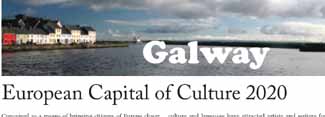
European Capital of Culture 2020 by Ita Marguet
Conceived as a means of bringing citizens of Europe closer together the project for an award of a European City of Culture was launched on 13 June 1985 by the European Council of Ministers on the initiative of the Greek Minister of Culture Culture, Melina Mercouri. Athens was chosen as the city for this prestigious event and a long list of others have followed.
Approaching the Millennium the concept, rules and name were revisited and in 1999 European City of Culture was changed to European Capital of Culture. In 2005 the Irish City of Cork was the first to be awarded under the new name. In Guidelines set by the Council of the European Union, the designated city … “shall establish a community action whose objectives shall be to highlight the richness and diversity of European cultures and features they share, as well as promote greater mutual acquaintance between European citizens”.
During one year the European Capital of Culture provides an opportunity to showcase its cultural life and cultural development. A number of European cities have used the event to transform their cultural base and, in doing so, the way in which they are viewed internationally. Culture can also be seen as a driving force for civilised urban development from which the chosen cities have derived significant economic and tourist benefits.
Galway: European Capital of Culture (ECoC)
In 2020 Galway is one of two European Capitals of Culture chosen to share the prestigious award with Rijika in Croatia. Beginning in the farthest reaches of Galway, on ‘St Brigid’s Day’ fiery celebrations will erupt in towns and villages across the county in keeping with the ancient traditions of the Irish Celtic calendar. The ceremony will travel across the county between 2-7 February encompassing An Spiédal, Tuam, Ballinasloe, Clifden, Portumna and Athenry before its final instalment at South Park in Galway City on 8 February. The President of Ireland, Michael D. Higgins, will officially inaugurate Galway 2020. It is Ireland’s fourth largest city and is home to the greatly expanded National University of Ireland (NUI). Many artistic, exploratory walks and other celebrations are scheduled or are due to be announced throughout the year to mark the event.
As an outpost facing west towards America and a gateway to Europe, Galway stands at a pivotal vantage point on the west coast of Ireland with its spectacular rugged and varied scenery. The city’s historic Spanish Arch is the remainder of a centuries old bastion as a reminder of the city’s multi-cultural, multi-lingual history and present day character where imagination and arts flourish. The surrounding landscape, culture and language have attracted artists and writers for generations. As tangible proof of the friendship between nations a life-size bronze sculpture placed on William Street, Galway City imagines the possible meeting in 1892 of the two writers, Oscar Wilde of Ireland (1856-1900) and Eduard Wilde of Estonia (1865-1933), sitting side by side, as it were, in long and lasting literary commune … “in the spirit of the Wildes”. Their literary genius and reputation have left their mark in Europe and around the world*.
In recent decades Galway has seen the rise of a burgeoning film, television and animation sector bringing significant economic activity to the area. Galway is expanding film audiences by building its first Art House Cinema and by supporting the city’s film festivals and increasing opportunities for film exhibitions in the region. Its overall vision is to showcase the rich heritage, tradition and legacy of film in the area, to broaden ongoing film activities and enrich the social, economic and cultural contributions across the region.
On 1 December 2014 the Director-General of UNESCO announced that Galway was designated a UNESCO City of Film. Under the ‘United Nations Creative Cities Network’ Galway became one of the only eight film centres in the world to achieve this much sought after status. The award is a permanent global designation and brings the highest internationally recognised standards of excellence in the creative industries. Ireland’s oldest Film Society started in Galway and has provided a vital platform to screen the work of the first wave of Irish film makers. It has continued to develop over the last thirty years with Galway City and county now boasting an impressive, healthy and growing film and television industry.
‘Tribes of Galway’
Known as ‘city of the tribes’, the term was first used during the seventeenth century to negatively describe a group of fourteen powerful and clannish families of Anglo-Norman origin in Co. Galway: Athy, Blake, Bodkin, Browne, Darcy, Deane, Ffrench, Ffront, Joyce, Kirwan, Lynch, Martin, Morris, and Skerrett. The pejorative term was later adopted by the families themselves as a badge of honour. Ita Marguet
Note: Acknowledgement is given to sources used in preparation of this text. It follows titles *Ireland and Estonia: The Wilde connection (2004,) European Capital of Culture, Cork (2005), UNESCO City of Literature, Dublin (2011), Irish City of Culture, Limerick (2014), by Ita Marguet.
article published on the April 2020 Edition No. 1, and will be found at P. 9 : http://internationaldiplomat.com/wp-content/uploads/2020/04/DIVAMagazine20202.pdf





